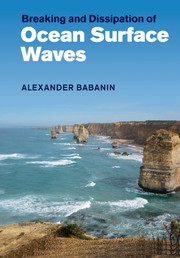Book contents
- Frontmatter
- Contents
- Preface
- 1 Introduction
- 2 Definitions for wave breaking
- 3 Detection and measurement of wave breaking
- 4 Fully nonlinear analytical theories for surface waves and numerical simulations of wave breaking
- 5 Wave-breaking probability
- 6 Wave-breaking severity
- 7 Energy dissipation across the wave spectrum
- 8 Non-dissipative effects of breaking on the wave field
- 9 Role of wave breaking in the air–sea interaction
- 10 Conclusions. What else do we need to know about wave breaking?
- References
- Index
9 - Role of wave breaking in the air–sea interaction
Published online by Cambridge University Press: 25 October 2011
- Frontmatter
- Contents
- Preface
- 1 Introduction
- 2 Definitions for wave breaking
- 3 Detection and measurement of wave breaking
- 4 Fully nonlinear analytical theories for surface waves and numerical simulations of wave breaking
- 5 Wave-breaking probability
- 6 Wave-breaking severity
- 7 Energy dissipation across the wave spectrum
- 8 Non-dissipative effects of breaking on the wave field
- 9 Role of wave breaking in the air–sea interaction
- 10 Conclusions. What else do we need to know about wave breaking?
- References
- Index
Summary
Wave breaking, apart from serving as the main dissipation source in the wave field, plays a number of other roles both on the ocean surface, and away from the surface. Chapter 8 was dedicated to such breaking-related other-than-dissipation features in the surface-wave system itself, and this penultimate chapter of the book, prior to Conclusions will extend the topic into a description of the roles wave breaking performs in air–sea interactions in a broader sense.
Section 9.1 and subsections are dedicated to the breaking-related effects in the atmospheric boundary layer. These are not limited to the wind–wave energy/momentum exchanges which have been discussed throughout the book. The breaking alters the sea drag, which then affects the near-surface air flow in general. The breaking is a source of spray, and the presence of the spray has a most essential influence on the boundary layer again. And finally, all these features have their peculiarities or even new behaviours, to a great extent unknown at this stage, in extreme conditions.
Section 9.2 also includes a number of subsections on important roles which the breaking plays in the upper-ocean dynamics and mixing. These cover descriptions of interface momentum and gas transfer, of which the breaking is part. In particular, two subsections are dedicated to the physical phenomena by means of which breaking facilitates such air–sea exchanges and mixing, i.e. the wave-induced turbulence and injection of the air bubbles under the water surface.
- Type
- Chapter
- Information
- Breaking and Dissipation of Ocean Surface Waves , pp. 350 - 404Publisher: Cambridge University PressPrint publication year: 2011



